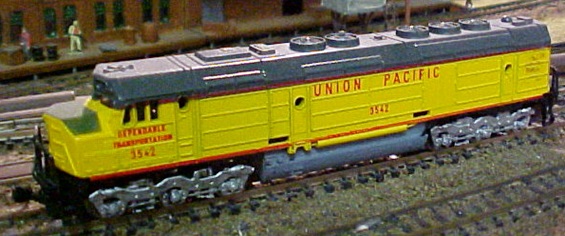

Introduced: 1970
Like the rest of Lima's line of horrendously awful N scale locomotives, their FP45 is, well, horrendously awful. And oddly enough, there are several different versions -
The first (and most common) version has a plastic chassis, a free-floating lead weight tossed into the fuel tank pocket, and a Lima piece-o-crap "pancake" motor attached to the rear truck (bottom mechanism in the above picture). The second version (top mechanism in the above picture) is essentially identical to the first excepting that it has an all-metal chassis (right down to the steps). Unfortunately, although the additional weight might allow this thing to pull more, the motor still sucks. So, kind of pointless. My experience on the secondary market is that the metal chassis'd versions are pretty hard to find. The one I ultimately wound up with came packaged in a "PMI" plastic box, so that might be one way to spot them (apart from the metal step ladders).
The early plastic-chassis versions are total junk. They're jerky, they're noisy, they wobble from side to side and they couldn't pull a fist full of smoke. The pickup isn't too bad, so they can make it around a circle of track pretty consistantly - so no "F" here, but just barely. As mentioned above, the metal-chassis'd versions seem to be a bit more stable and can undoubtedly pull more, but still... y'know.
Picking on the lighting seems a tad unfair at this point, but's let's go for it anyway. First off, the so-called "headlight" is non-directional. And to make matters worse, it's not located anywhere near the front of the locomotive, so the end result is a rather pathetic display of light spewing from virtually every window in the shell.

The third (and hardest to find) version not only sports a metal chassis, but also has an actual, honest-to-gosh can motor. And true to Lima engineering form, they somehow managed to screw this one up as well. The new motor (combined with the additional heft of the metal chassis) makes for a potentially decent running locomotive. Why, put it on some straight track and it's just as smooth and as quiet as can be - excellent throttle response, etc (ya, OK, still a bit wobbly, but whatever). Unfortunately, Lima decided that we didn't need any pick-up from the newly redesigned driving truck and basically turned this thing into an 0-6-0 as far as current draw is concerned. And yeah, you guessed it, it absolutely dies when faced with any kind of turnout (or simply a moderate stretch of dirty track). O Lima! So close, yet so far!
So, all things considered, I'd probably rate the metal-chassis/pancake-motor version with the all-wheel pick-up the "best" overall performer. But c'mon, ultimately we're talking about varying shades of crap here.
This model has had various importers (AHM and PMI for starters). As far as who imported what when, your guess is as good as mine. My "theory" is that AHM dealt in the early plastic-chassis version, PMI got the metal-chassis/pancake-motor version, and the later can motor version came in "Lima" packaging (as pictured above, and imported by god knows whom). But, that's all speculation based on the few examples that I've actually purchased off of eBay. Lima's entire line of North American models was discontinued circa 1992 when Lima was purchased by Rivarossi (although this particular model may have been retired well before that).
Trivia - these shells are reportedly a good fit for either an Atlas SD50 or a Kato SD40-2 chassis (for those interested in having an FP45 that will actually run).
More trivia - Circa 2005, the tooling/molds for Lima's FP45 shell were acquired/recycled by something called "Del Prado" (for use in their line of static display models). These Del Prado models tend to go for dirt cheap prices (often from European resellers), so if you're looking for an FP45 shell, you might try one of these.
Grade: D